Brooklyn
Brooklyn sits on the western tip of Long island, and the first Dutch settlers arrived in the area in 1625 only 12 years after a trading post was established on Manhattan Island. The village of Breuckelen was established in 1646, named after Breukelen in the Netherlands. After the British took over the area in 1664 the name was anglicised to to Brockland which over time evolved into Brooklyn. Growth led to city status 1834 and over the following decades growth was accelerated by the incorporation of nearby towns and cities including the City of Williamsburgh and the Town of Bushwick. The resultant mixed heritage means that the road layout does not have a standardised grid pattern, which is part of the charm of modern day Brooklyn. The Borough of Brooklyn now has a population of around 2.5 million, nearly a million more than Manhattan.
Willow Street, Brooklyn Heights
If you want to get a feel for Brooklyn, then a walk around Brooklyn Heights is a must. Located on a bluff that runs along the East River, Brooklyn Heights was the site of the first battle between Washington’s Continental Army and the British after the Declaration of Independence. The British won the battle and imposed heavy losses on the Continental Army, but Washington managed to organise a retreat across the East River. By the early 1800s fast steam ferries across the river had begun the process of integrating Brooklyn with Manhattan, with Brooklyn Heights turning into a commuter suburb of New York. Victorian commuter houses still abound in Brooklyn Heights and one of the best views of Lower Manhattan can be seen from the bluff along the East River.
Japanese Hill & Pond Garden, Brooklyn Botanical Garden
Brooklyn is tied to Manhattan by a swathe of bridges and subway lines, making travel easy for commuters living here at the western end of Long Island. It is out here that the City established the Botanic Garden that every major world city must have. Founded in 1910 on a 16 hectare (39 acre) site the Brooklyn Botanic Garden has a wide range of plant life and gardens in many different styles. This picture shows the Japanese Hill and Pond Garden designed in 1915 by landscape architect Takeo Shioto. The garden was restored in 2000.
Brooklyn Museum of Art
A subway journey of only half an hour from Midtown Manhattan can take you to the Brooklyn Museum of Art. The museum traces its roots right back to the Brooklyn Apprentices’ Library founded in 1823 in Brooklyn Heights to educate young tradesmen. In 1843 it formed the Brooklyn Institute by merging with the Brooklyn Lyceum and a few years later it announced plans to establish a permanent gallery of fine arts. The Brooklyn Museum opened in 1897 in this building designed by architects McKim, Mead & White. The museum has a permanent collection of more than one-and-a-half million objects spanning the ages from ancient Egypt to modern art.
Boathouse & Prospect Lake, Prospect Park
Prospect Park is Brooklyn’s answer to Manhattan’s Central Park, indeed it was designed by the same people, Frederick Law Olmsted and Calvert Vaux. Land for the park was purchased in 1860, but the Civil War put the park on hold. Construction of the 237 hectare (585 acre) park began in 1866. The major features of the design were a Long Meadow, a wooded area called The Ravine, and a 24 hectare (60 acre) lake. We visited the park at the height of summer, only to find that the lake was covered by a layer of green weed. We found Prospect Park much quieter than Central Park, a rural oasis in the city with no overlooking skyscrapers.
Soldiers' and Sailors' Memorial Arch, Grand Army Plaza
At the main entrance to Prospect Park, Olmsted and Vaux designed a an oval shaped plaza originally called Prospect Park Plaza. In 1889 the Soldiers and Sailors Monument Commission decided to build a memorial at the centre of the plaza. Construction of the triumphal arch commenced later that year and was completed in 1892. The design of the arch was inspired by the Arc de Triomphe in Paris. In 1926 the plaza was renamed Grand Army Plaza.
Click on Minimap to navigate
Home > US States > Midatlantic USA > New York > New York City >
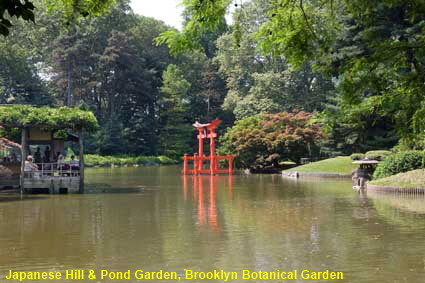
Coney Island boardwalk
On the south coast of Brooklyn at the end of a long subway ride stands Coney Island, once known as ‘the playground of the world’. In the early 20th Century Coney Island was famed for its amusement parks such as Luna Park, Dreamland and Steeplechase Park. What happened to them? They succumbed to the fire and rising land prices, so one by one they closed down and were built over. When we first visited Coney Island in 2005 there were large areas of derelict land and the remaining amusements were a pale shadow of its heyday. However you could (and can) still get a feel for the glory days at the quirky Coney Island Museum. When we went back in 2019 we were pleasantly surprised. Tacky amusements such as ‘Shoot the Freak’ had been replaced by a new park called Luna Park after the park that closed in 1945. The new park opened in 2010 on the site of the former Astroland park. Click Tab 2 to see the boardwalk in 2008 complete with ‘Shoot the Freak’. The Wonder Wheel visible in the background is in Deno’s Wonder Wheel Amusement Park and has been operating since 1920.
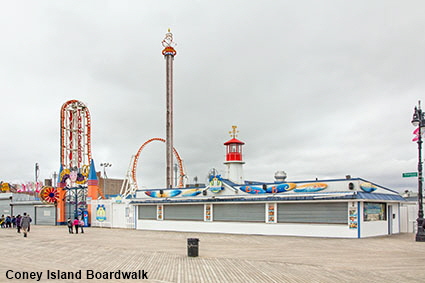
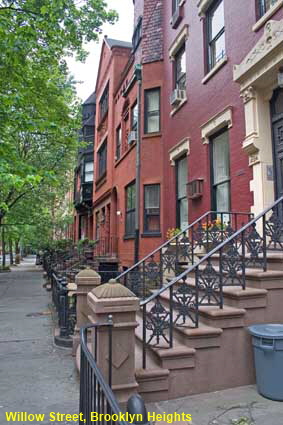
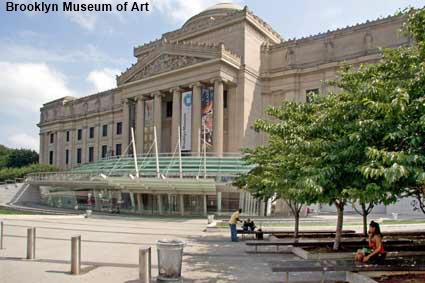
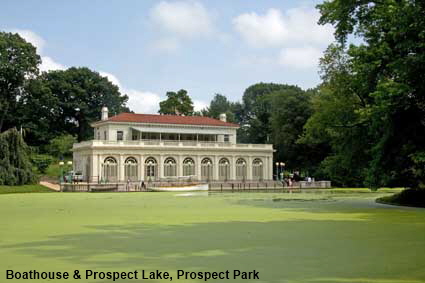
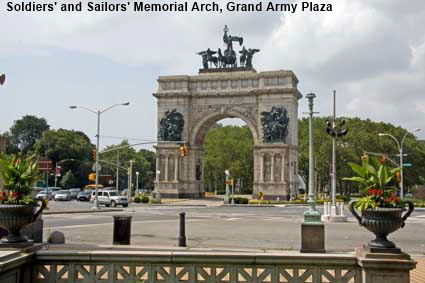
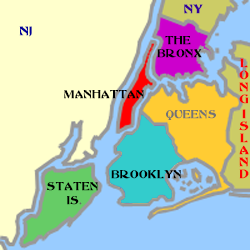
DLU190521


To move forwards or backwards through the New York City trail click the arrows above, or select your next destination on the Minimap.
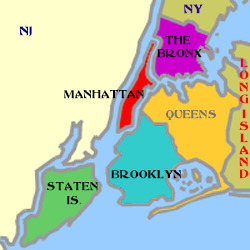
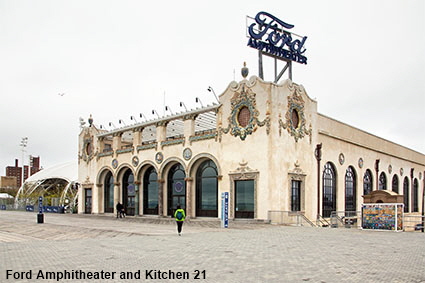
Ford Amphitheater and Kitchen 21
When we visited in both 2005 and 2008 the former Child's Restaurant was derelict. How times had changed when we went back in 2019. The 1923 restaurant building has been renovated and now houses a new restaurant called Kitchen 21 plus the booking office for the Ford Amphitheater which is visible in the picture to the left of the building. The restaurant serves fast food and has a rooftop lounge and bar. The 5,000 seat Amphitheater is used for a summer season of live music. Click Tab 2 to see the inside of the Amphitheater or Tab 3 to see the derelict Child’s Restaurant building back in 2008.
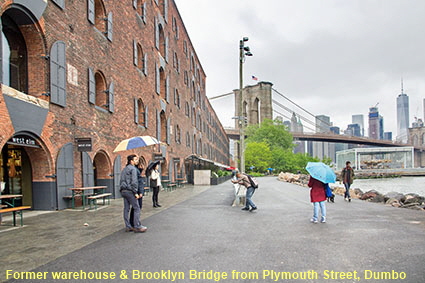
Former warehouse & Brooklyn Bridge from Plymouth Street, Dumbo
An area that is definitely going up in the world is Dumbo, which stands for ‘Down Under Manhattan Bridge Overpass’ Originally a warehouse and ferry terminal district are known as Gairville, Dumbo spreads both sides of the bridge overpass giving superb views of both Manhattan and Brooklyn Bridges. The whole area was bought up by a developer who turned the warehouses into a mix of housing, offices for technology startups, art galleries, shops and restaurants. Click Tab 2 to see Manhattan Bridge looming over Dumbos’s Washington Street.
© Mike Elsden 1981 - 2025
The contents of this page may not be reproduced in full or in part without permission